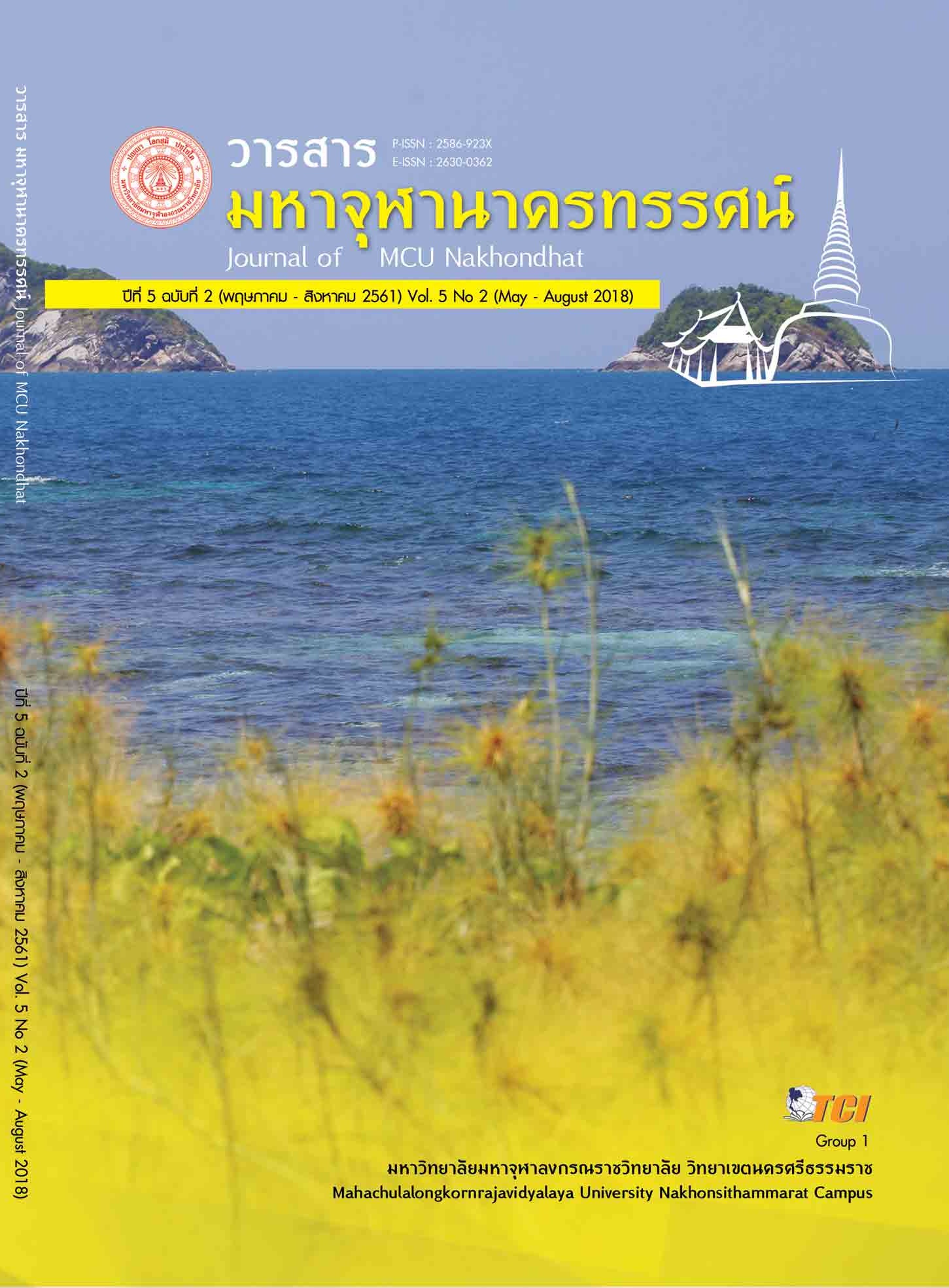The Knowledge and Good Death Practical Path Promotion Base on Buddhism
Main Article Content
Abstract
The research on “The knowledge and good death practical path promotion base on Buddhism” contained 3 objectives: 1) to study and analyze knowledge of good death in three dimension such as medical, law and Buddhist; 2) to study the best practices of good death practical path promotion in community, Buddhist temple and model organization in Thai society; 3) to develop curriculum and learning process for creative model innovation of good death practical path. This research was action research developing activities about good death practical path based on Buddhist integration to training 79 Buddhist monks and researches.
This research were found that;
Firstly, the knowledge and good death practical path based on Buddhist integration emphasize individual to consider mind and ordinary life as Happening, existing and ending are the truth. Its will make a preparing and understanding in mind and wisdom for death and let the people ready to pass away. In medical dimension, death is basic concept of life but medical will tend and heal for make life a healthy, quality, honestly and dignity. And before the end of life is coming, palliative care is importance to use for everyone. In law dimension, death is the end of any juristic acts. By the way there is living will and patience right to denial of treatment.
Secondly, there are twelve best practice organization and communities that have promoted paths of good death practice. By learning from social dynamic particularly the coming of aging society, increasing of terminal stage and impacts of palliative care in present Thai society. The best practice organization and communities’ embodiment good death knowledge to factual work. Such as the group of volunteers that always patrol a palliative care activities in their own community.
Thirdly, there are two curriculums for develop Buddhist monk to work in field of palliative care comprise Buddhist volunteer for good death and research innovation for good death on Buddhist principle. Both of curriculums emphasis to extend good death knowledge and Buddhist monk networks on good death.
Article Details
References
ดรรชนี สินธุวงศานนท์. (2558). บูรณาการดูแลผู้ป่วยมะเร็งระยะสุดท้ายด้วยการประยุกต์ใช้หลักพุทธธรรมในพระพุทธศาสนาเถรวาท. วารสารวิทยาลัยพยาบาลบรมราชชนนี นครราชสีมา, 21(1), 54-64.
เต็มศักดิ์ พึ่งรัศมี. (2542). Palliative Care การดูแลเพื่อบรรเทาอาการ วิถีแห่งการคลายทุกข์. กรุงเทพฯ: หมอชาวบ้าน.
ทัศนีย์ ทองประทีป. (2552). พยาบาล: เพื่อนร่วมทุกข์ผู้ป่วยระยะสุดท้าย (Nurse : Being With The Dying). (พิมพ์ครั้งที่ 2). กรุงเทพฯ: จุฬาลงกรณ์มหาวิทยาลัย.
บังอร ไทรเกตุ. (2556). การดูแลผู้ป่วยระยะสุดท้ายแบบประคับประคอง (Palliative Care). กรุงเทพฯ: พิมพ์ดี จำกัด.
พระพรหมคุณาภรณ์ (ป.อ. ปยุตฺโต). (2551). การแพทย์ยุคใหม่ในพุทธทัศน์. กรุงเทพฯ: สหธรรมิก.
พระไพศาล วิสาโล. (2552). เหนือความตาย : จากวิกฤตสู่โอกาส. (พิมพ์ครั้งที่ 4). กรุงเทพฯ: เครือข่ายพุทธิกาและมูลนิธิโกมลคีมทอง.
พระมหาสุพร รกฺขิตธมฺโม (ปวงกลาง). (2557). ศึกษาวิเคราะห์การเผชิญความตายอย่างสงบตามหลักมรณสติในพระพุทธศาสนาเถรวาท. ปริญญาพุทธศาสตรดุษฎีบัณฑิต สาขาวิชาพระพุทธศาสนาบัณฑิตวิทยาลัย มหาวิทยาลัยมหาจุฬาลงกรณราชวิทยาลัย.
พระราชบัญญัติสุขภาพแห่งชาติ พ.ศ. 2550. (2550, 19 มีนาคม). ราชกิจจานุเบกษา. เล่ม 124 ตอนที่ 16 ก . สำนักเลขาธิการคณะรัฐมนตรี.
พุทธทาสภิกขุ. (2549). ตายก่อนตาย. กรุงเทพฯ: ธรรมสภา.
มัฏฐวรรณ ลี้ยุทธานนท์, ผกาสรณ์ อุไรวรรณ และ จริญญา แก้วสกุลทอง. (2560). ความรู้และการดูแลผู้ป่วยระยะสุดท้ายทางจิตวิญญาณของพระภิกษุสงฆ์ในเขตภาคใต้ตอนบน. วารสารสันติศึกษาปริทรรศน์ มจร, 5(3), 256-267.
สันต์ หัตถีรัตน์. (2552). การดูแลผู้ป่วยให้ตายดี. (พิมพ์ครั้งที่ 3). กรุงเทพฯ : หมอชาวบ้าน.
สำนักงานคณะกรรมการสุขภาพแห่งชาติ. (2557). แผนยุทธศาสตร์ระดับชาติว่าด้วยการสร้างเสริมสุขภาวะในระยะท้ายของชีวิต พ.ศ. 2557-2559. กรุงเทพฯ : สามดีพริ้น ติ้งอีควิปเมนท์ จำกัด.
สุธี อยู่สถาพร. (2550). แนวคิดและการจัดการกับการตาย:กรณีศึกษาเงื่อนไขทางสังคม เศรษฐกิจและกฎหมาย. วารสารบริหารงานสาธารณสุข, 13(2), 10-19.
สุนันทา เอ๊าเจริญ และคณะ. (2560). ผลของโปรแกรมการลดภาวะซึมเศร้าใน ผู้ป่วยโรคติดต่อไม่เรื้อรังด้วยพุทธบูรณาการ. วารสารสันติศึกษาปริทรรศน์ มจร, 5(1), 89-102.
แสวง บุญเฉลิมวิภาส. (2558). การรักษาพยาบาลผู้ป่วยวาระสุดท้าย: ความจริงทางการแพทย์กับของเขตทางกฎหมาย. วารสารกฎหมายสุขภาพและสาธารณสุข, 1(3) , 241-253.
Banta, H. David and Luce B. (1993). Health Care Technology and Its Assessment: An International Perspective. Oxford: Oxford University Press.


